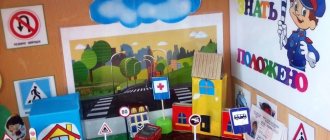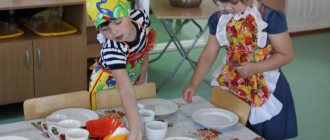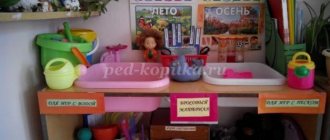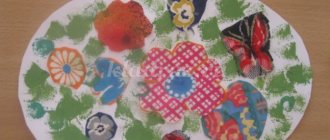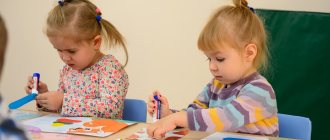Subject-developmental environment in the middle group of kindergarten within the framework of the Federal State Educational Standard
Slide 1 Subject-based developmental environment in the middle group of a kindergarten within the framework of the Federal State Educational Standard. Completed by: Levshakova O.V, teacher of MBDOU “Kindergarten No. 18” “Crane” Specialist of the 1st qualification category
Slide 2 Subject development environment in preschool educational institutions. Particularly relevant today is the issue of organizing the subject-development environment of preschool educational institutions. This is due to the introduction of the Federal State Educational Standard (FSES) to the structure of the basic general education program of preschool education. In accordance with the Federal State Educational Standard, the program should be built taking into account the principle of integration of educational areas and in accordance with the age capabilities and characteristics of students. The solution of program educational tasks is provided not only in the joint activities of adults and children, but also in the independent activities of children, as well as during routine moments. Everyone knows that the main form of work with preschoolers and the leading activity of children is play. That is why we educators are experiencing an increased interest in updating the subject-development environment of preschool educational institutions.
Slide 3 What is a subject-specific developmental environment? (Terminology) The child’s development environment in the structure of the Federal State Educational Standard is a complex of material and technical, sanitary and hygienic, social, social, social, ergonomic, aesthetic, psychological, pedagogical, and spiritual conditions that ensure the organization of the lives of children and adults in preschool educational institutions.
Slide 4 Federal State Educational Standard requirements for a subject-development environment: 1. Accessibility for students of all premises of the organization where the educational process is carried out. 2. Free access for pupils to games, toys, materials, and aids that provide all basic activities.
Slide 5 Factors that should be taken into account when organizing PRS. Children should be protected in every possible way from the negative influence of toys that: provoke the child to aggressive actions and cause cruelty, provoke game plots associated with immorality and violence that are beyond the competence of childhood. Anthropometric factors ensuring compliance of height and age characteristics with the parameters of the subject development environment. Furniture must be in accordance with the requirements of SANPiN and Federal State Standards
Slide 6 The subject development environment should facilitate the implementation of educational areas in the educational process, including: 1) joint partnership activities of adults and children; 2) free independent activity of the children themselves in the conditions of a subject-based developmental educational environment created by teachers, which ensures that each child chooses activities according to his interests and allows him to interact with peers or act individually.
Slide 7 The subject-spatial development environment should be organized taking into account the requirements of the Federal State Educational Standard, where all five educational areas are clearly visible: 1) socio-communicative,
2) educational,
3) speech,
4) artistic and aesthetic,
5) physical.
Slide 8 Approximate centers for educational areas in light of the requirements of the Federal State Educational Standard Social and communicative development: Cognitive development: Speech development Artistic and aesthetic development Physical development: Traffic Safety Center
Fire Safety Center
Labor Center, Duty Corner
Game activity center (center for role-playing games)
Sensory Development Center
Center for Constructive Activity
Center for Mathematical Development
Experimentation Center Speech Development Center or Speech and Literacy Corner
Speech therapy corner Fine Arts Center or creativity corner
Center for Musical and Theatrical Activities Center for Physical Development - Sports Corner “Be Healthy!”
Slide 9 When creating a subject-development environment in our group, we set ourselves the goal of doing this with minimal economic costs, since we cannot count on serious material investments in equipping the subject environment. We tried to make the subject-development environment diverse, bright, and rich in information, in order to maximally speed up and facilitate the adaptation period of children in kindergarten, create an emotionally positive atmosphere in the group, and ensure the individual harmonious development of the child. We followed the zoning principle. Thanks to the organization of various play areas and corners using open shelving that does not clutter the room. The group has created conditions for different types of children's activities (play, productive and cognitive-research). In order for each child to be able to find something to do and do something they like and feel comfortable, centers for a specific type of activity are allocated in the group.
Slide 10 Direction: Artistic and aesthetic development. There is material and equipment for artistic and creative activities: drawing, modeling and appliqué. If desired, the child can find and use what is necessary to realize his creative ideas, plans, and fantasies. This center has free access.
Slide 11 Direction: Speech development plays a significant role in developing children’s interest and love for fiction. In this corner, the child has the opportunity to independently choose a book according to his taste and calmly examine it with bright illustrations.
Slide 12 Direction: Cognitive development. Center for Experimental Activities. It contains material for carrying out experimental activities: magnifying glasses, flasks, measuring cups, funnels, hourglasses, soil, stones, seeds, cereals, etc. Our little “whys” conduct simple experiments and determine the properties of various natural materials.
Slide 13, 14 includes environmental activities. This corner contains various types of indoor plants, which are convenient for demonstrating modifications of parts of the plant, tools for caring for these plants: sticks for loosening, a spray bottle, watering cans, etc. In addition to indoor plants, this center contains models (desert, animal world, aquarium , birdhouse, beehive, birdcage, etc.).
Slide 15 It’s winter outside, but in the group on the windowsill it’s spring. During the cold season, my children and I create a mini-vegetable garden on the windowsill. This is an opportunity for children to have live communication with plants. Anyone who starts such a vegetable garden will certainly become interested in experimentation and eco-design. I arranged the winter garden with great imagination: I designed it in the form of a village yard, decorated it with suitable buildings and decorative accessories.
Slide 16 The “construction” (constructive) center, although concentrated in one place and takes up little space, is quite mobile. Its practicality lies in the fact that with the contents of the construction corner (various types of construction sets, large and small construction sets), you can move to any place in the group and organize this activity.
Slide 17 (toy library) The center solves the following tasks: purposefully developing children’s interest in elementary mathematical activities, instilling in children the need to occupy their free time with not only interesting, but also games that require mental stress and intellectual effort.
Slide 18 Direction: Social and personal development. Play is the main activity of our children. A bright, rich play center creates conditions for children’s creative activity, develops imagination, develops gaming skills and abilities, and fosters friendly relationships between children. Attributes for role-playing games emerging at this age are freely available to children: “Family” “Hospital”
Slide 19 “Barbershop”
"Theater"
Slide 20 “Shop” “Garage”
Slide 21 «
The importance of cognitive development of children in the middle group of preschool educational institutions
In government preschool institutions, everything is created to ensure that children have the opportunity to satisfy their curiosity. In order for the development of the cognitive sphere to be effective, it is necessary to organize special events.
Note! Activity in any of its manifestations is an important component for the harmonious development of preschool children. Indeed, in cognitive activity, children study the world around them, interact with various objects and acquire specific skills.
Cognitive development in the middle group of kindergarten expands ideas about the environment and enriches vocabulary. Experienced teachers recommend conducting classes in a natural corner, a music area, or a place for playing on the floor. All the necessary attributes are placed using the mosaic method so that children do not interfere with each other while playing.
The main goals and objectives of cognitive development in children 4-5 years old
The main tasks of cognitive activity are to encourage curiosity, identify the baby’s interests, formulate actions that are aimed at understanding the world around him, and develop creative inclinations. In addition, the main goals include the following:
- formation of knowledge about oneself as an individual;
- familiarization with concepts such as color, shape, volume and quantity;
- children study their homeland, get acquainted with the cultural values and customs of their country.
In addition, the little ones gradually learn that the animal and plant world can be diverse, since during classes they work with local specimens.
Formation of mathematical concepts in children
Mathematical knowledge plays an important role in the development of a child, because with the help of various techniques, children develop pre-numerical and numerical ideas and knowledge about the shapes, sizes and locations of objects in space. And this, in turn, is necessary to ensure general developmental orientation, training, and connection with mental and speech development.
Cognitive research activities and sensory development
The emergence of cognitive-research activity occurs at an early age on the basis of subject-manipulative cognition. It is a simple and “purposeless” experimentation with things, during which the categorization of objects by color, shape, and purpose appears. The development of sensory standards and simple instrumental actions also occurs.
Sensory development in the garden
As for sensory education, with its help the child learns the standard external properties of objects: their color, size, as well as aroma and taste. The age of 4-5 years is most suitable for improving the senses of touch and accumulating ideas about the world around us.
Getting to know the world of objects
At 4-5 years of age, the child develops ideas about objects and natural phenomena that the toddler often encounters. During object-sensory education in classes or in play, the preschooler observes, identifies and identifies individual signs of vegetables, plants and domestic animals, and also learns to distinguish between the signs of winter, spring, autumn and summer.
Open mathematical classes in older groups in the form of games
Important! With the help of such sensory standards as color, shape and size, kids compare phenomena and objects and combine them into groups according to external characteristics.
Introduction to society
Child psychologists and teachers argue that the priority direction for getting to know society is to form the foundations of a person’s basic culture, prepare a preschooler for life in modern society and develop creative potential. To interact with the family and society, teachers should arrange excursions to objects located outside the kindergarten territory as often as possible.
Introduction to the natural world and environmental education
The environmental education of children in the middle group of preschool educational institutions has an important social significance for the whole society. It is extremely important that the foundations of ecological culture in the human personality are laid in a timely manner.
The teacher should tell the kids how animals will spend the winter in the forest, and direct the children’s active activities so that they consciously preserve nature (pets, birds), have environmental knowledge and have a moral attitude towards the world and space. It would also be a good idea to study all the months (January, February, March, etc.) with preschoolers.
